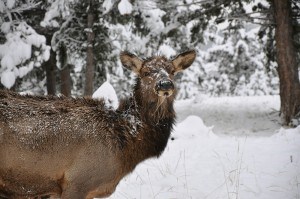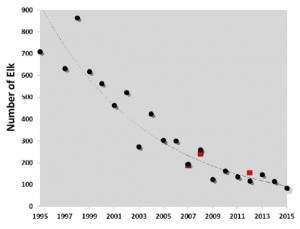
In late November, Parks Canada staff conducted the 29th annual roadside elk survey in Jasper National Park.
The roadside survey provides Parks with an index or baseline of the approximate number of elk in the park and, by using the same protocol every year, gives an idea of any long term changes in the population.
Information from the roadside elk count is useful to many park programs. The data aids everything from elk management for visitor safety, to aspen monitoring, to caribou conservation (elk are a food source for wolves and therefore the number of elk can have an affect on caribou populations) and restoring healthy ecosystems.
The history of elk in Jasper is an interesting one. When Europeans first came to this area in the 1800s, they could not find elk in the main valley around Jasper. However, there were a few in the Snake Indian and Brazeau valleys nearby.
Once the park was established, the low numbers of elk observed prompted the Superintendent of Jasper National Park to bring in elk from Yellowstone National Park in 1920, introducing them into the main valley as a food source for the local predator population.
Due to hunting and predator control at that time, there were limited predators in the area and the introduced elk population quickly reached several thousand and overgrazed their range. In 1959, policies around predator control began to change and the subsequent long term declines in both the elk and caribou populations can be attributed to the subsequent resurgence of predators.

Predation is a natural process that is part of a healthy ecosystem, but several thousand elk in the main valley represented an unnaturally dense food supply that eventually resulted in unusually high numbers of predators.
Elk did not start wintering in the townsite until 1980, and it wasn’t until 1985 that some elk began living in or around Jasper year-round to avoid predators. Now, almost all elk in the main valley spend their winters within 10 km of town, and there are many elk that never venture far from areas occupied by people.
So, while the total number of elk throughout the park is substantially less than it was several decades ago, there are still areas near town with more elk than ever before.
The survey data from 2015 indicates there is a declining elk population in the main valley of Jasper National Park, but the rate of that decline continues to slow. This tells us that the historical overpopulation of elk seems to be at or nearing its end. While this is a positive sign, the elk population in Jasper National Park continues to be a species of management concern. While the number of elk has been decreasing, the number of elk/human conflicts have increased due to the increasing use of the townsite area as a refuge from predators by the remaining elk.
The safety of visitors and residents is a priority for Parks and we remind the public to never approach wildlife and always be on the lookout for animals or signs of their presence.
Please consider the elk and drive carefully in Jasper National Park, and report aggressive elk to dispatch at 780-852-6155. Please visit the Parks website for more information and safety tips: www.pc.gc.ca/jasper.
Parks Canada Special to the Fitzhugh
